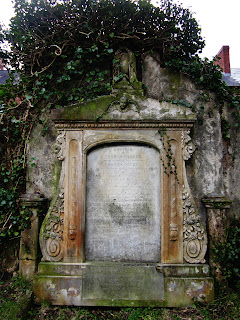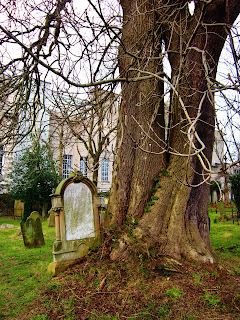Friar’s Bush Cemetery
Situated on Stranmillis Road, Friar’s Bush cemetery is Belfast’s oldest Christian burial site. Hidden from view behind a huge wall and the Ulster Museum, it is quite a small graveyard - roughly two acres - but is the final resting place of a deceptively large number of people. The city’s official famine site, part of it is a mass grave of over 2,000 victims of hunger and cholera. Dating back to the 13th century, it is also said to be the site of the medieval friary of St Patrick himself. Every grave tells a story; most of famine and plague, some of bloody murder and body-snatching.
The entrance to the cemetery - a beautiful old arched gothic gate lodge, was built by the Marquis of Donegal in 1828. One of the first things you see as you pass through the gate is a sizable mound looming up from the earth before you. Dubbed ‘the Plaguey Pit’, this mound marks the final resting place of thousands of unfortunates who died during a major outbreak of cholera in the early 1830s. Too poor to afford to be buried, they were lain together in this mass grave, which was used again to bury countless victims of the Great Famine.
During the Penal persecution of the 18th century, when the practice of Mass was strictly forbidden, many of Belfast’s Catholic citizens would secretly attend Mass in Friar’s Bush - which at the time was one of many secret ‘Mass Stations’ throughout the land - under the very thorn tree that gives the cemetery its name. Many tales tell of various priests who were hanged from the thorn tree as punishment for practising their religion. According to journalist James Bartlett, the Ulster Observer printed the following in 1867: “The poor priest had no other shelter than was afforded by the venerable old thorn, which on one occasion did the double duty of shadowing the Mass and afterwards serving as a gallows for the poor friar.” The cemetery is also home to the mysterious ‘Friar’s Stone’ - said to stand where the body of the friar fell from the tree. It is marked AD 485, though local historians doubt its authenticity.
Bartlett also suggests there are countless anonymous dead buried in Friar’s Bush, tragically including still-born babies of local servants who couldn't afford to pay for burial, or had been refused burial if the infants were not baptised. Some times these young women reputedly threw their babies over the wall for sympathetic gravediggers to bury.
At the beginning of the nineteenth century, Edinburgh had begun to make a name for itself as an important centre for the study of anatomy. Students were occasionally assigned cadavers – usually an executed criminal – on which to practice their studies. However there was never a sufficient amount due to a decrease in the number of executions at this time. Students and surgeons had to seek other ways - morbid, darker ways - with which to obtain corpses, and many turned increasingly to body-snatchers - resurrectionists - for a fresh supply of ‘specimens.’ These grave robbers often came across the sea to Ireland in their grisly work, and Friar’s Bush cemetery was one of many targeted by them. In 1823 the exhumed corpses of a woman and a young child were discovered inside a barrel on a ship bound for Scotland. According to the Belfast News Letter (15th July, 1823), the culprits responsible for stealing the bodies (later revealed to be those of the wife and child of a shoe-maker from Forest Lane, Belfast) were Burke and Hare wannabes George Stewart and his sidekick Feeny. Found drunk at their lodgings in Belfast, after having travelled here from Scotland to obtain corpses for clients and ship them back under the cover of night, they allegedly had in their possession a large brass syringe, a surgeons knife, forceps and five sovereigns.
In 1869, when it became clear the earth at Friar’s Bush could hold no more bodies, Milltown Cemetery was established as the city’s main Catholic cemetery. Nowadays the gates at Friar’s Bush remain firmly locked, though tours of the site are permissible by request. It’s a curious little boneyard; situated in the shadow of the Ulster Museum on a busy street, most people pass it by without realising it is even there. Wonderfully atmospheric, it is one of Belfast’s best kept secrets.
Accompanying me on my exploration of Friar’s Bush cemetery was Marie Robinson - author, folklorist and contributor to Fascination With Fear and Destroy the Brain - and her two friends, who were all visiting Ireland from Missouri last week. It’s great to meet up with online buddies from the horror community - and even better when you can explore spooky old cemeteries together.
The entrance to the cemetery - a beautiful old arched gothic gate lodge, was built by the Marquis of Donegal in 1828. One of the first things you see as you pass through the gate is a sizable mound looming up from the earth before you. Dubbed ‘the Plaguey Pit’, this mound marks the final resting place of thousands of unfortunates who died during a major outbreak of cholera in the early 1830s. Too poor to afford to be buried, they were lain together in this mass grave, which was used again to bury countless victims of the Great Famine.
During the Penal persecution of the 18th century, when the practice of Mass was strictly forbidden, many of Belfast’s Catholic citizens would secretly attend Mass in Friar’s Bush - which at the time was one of many secret ‘Mass Stations’ throughout the land - under the very thorn tree that gives the cemetery its name. Many tales tell of various priests who were hanged from the thorn tree as punishment for practising their religion. According to journalist James Bartlett, the Ulster Observer printed the following in 1867: “The poor priest had no other shelter than was afforded by the venerable old thorn, which on one occasion did the double duty of shadowing the Mass and afterwards serving as a gallows for the poor friar.” The cemetery is also home to the mysterious ‘Friar’s Stone’ - said to stand where the body of the friar fell from the tree. It is marked AD 485, though local historians doubt its authenticity.
Bartlett also suggests there are countless anonymous dead buried in Friar’s Bush, tragically including still-born babies of local servants who couldn't afford to pay for burial, or had been refused burial if the infants were not baptised. Some times these young women reputedly threw their babies over the wall for sympathetic gravediggers to bury.
At the beginning of the nineteenth century, Edinburgh had begun to make a name for itself as an important centre for the study of anatomy. Students were occasionally assigned cadavers – usually an executed criminal – on which to practice their studies. However there was never a sufficient amount due to a decrease in the number of executions at this time. Students and surgeons had to seek other ways - morbid, darker ways - with which to obtain corpses, and many turned increasingly to body-snatchers - resurrectionists - for a fresh supply of ‘specimens.’ These grave robbers often came across the sea to Ireland in their grisly work, and Friar’s Bush cemetery was one of many targeted by them. In 1823 the exhumed corpses of a woman and a young child were discovered inside a barrel on a ship bound for Scotland. According to the Belfast News Letter (15th July, 1823), the culprits responsible for stealing the bodies (later revealed to be those of the wife and child of a shoe-maker from Forest Lane, Belfast) were Burke and Hare wannabes George Stewart and his sidekick Feeny. Found drunk at their lodgings in Belfast, after having travelled here from Scotland to obtain corpses for clients and ship them back under the cover of night, they allegedly had in their possession a large brass syringe, a surgeons knife, forceps and five sovereigns.
In 1869, when it became clear the earth at Friar’s Bush could hold no more bodies, Milltown Cemetery was established as the city’s main Catholic cemetery. Nowadays the gates at Friar’s Bush remain firmly locked, though tours of the site are permissible by request. It’s a curious little boneyard; situated in the shadow of the Ulster Museum on a busy street, most people pass it by without realising it is even there. Wonderfully atmospheric, it is one of Belfast’s best kept secrets.
Accompanying me on my exploration of Friar’s Bush cemetery was Marie Robinson - author, folklorist and contributor to Fascination With Fear and Destroy the Brain - and her two friends, who were all visiting Ireland from Missouri last week. It’s great to meet up with online buddies from the horror community - and even better when you can explore spooky old cemeteries together.

































